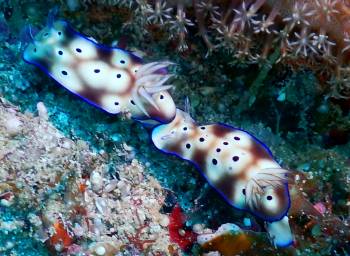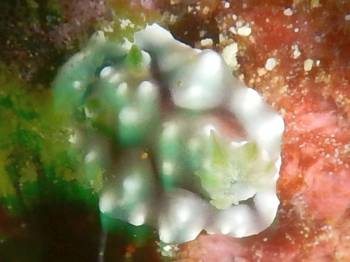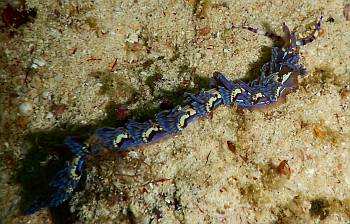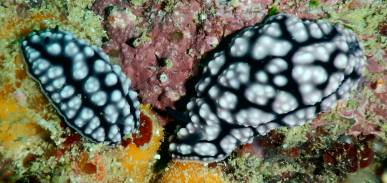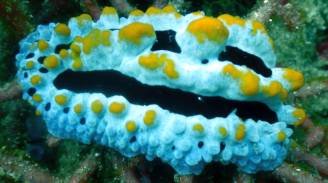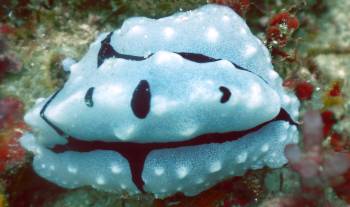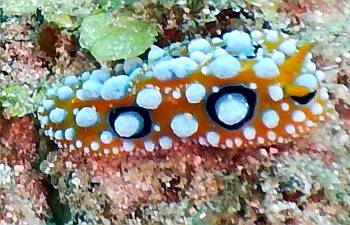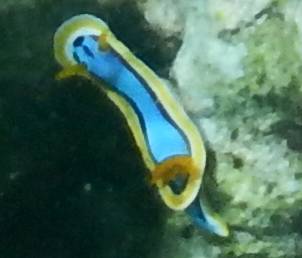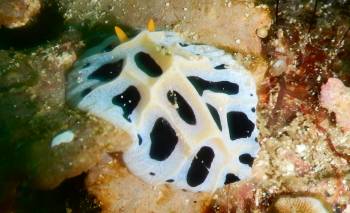|
Underwater Pages Reef Animals |
Nudibranchs
Picasso Critters on the Reef
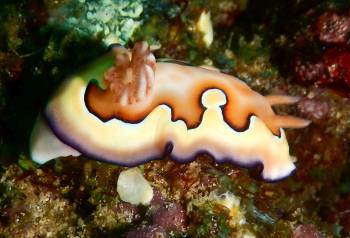 The naked gills of a nudibranch look like feathers |
Nudibranchs, or nudis as they are affectionately called, are some of our favorite sea critters: colorful, bizarre, and endlessly challenging to find. Their small size (often less than 1 inch!) makes them a real challenge for our age-hindered eyes!
In layman terms, "nudibranch" is sort of a catch-all name for a whole group of generally small, colorful sea critters that are often oblong or cylindrical and maybe only an inch or 2 long (though the flamboyant Spanish Dancer nudibranch can attain 18 inches!). Many people lump almost any soft-bodied, colorful critter into the "nudibranch" category.
Nudibranchs, aka Sea Slugs, belong to the Phylum Mollusca, a huge Phyllum of animals that includes all the sea shells and bivalves like clams, cephalopods like squid and octopus. There are literally tens of thousands of species of Mollusks in the world, and most live in the ocean.
More specifically, nudibranchs are part of the Class Gastropoda, Subclass Opistobranchia. Sea slugs generally have soft bodies (no external shells) and their mantles are brilliantly colored and cover their backs. Nudibranch literally means "naked gills" and most of these creatures have feathery masses on their bodies that are their naked, external gills. They are of many shapes and colors, but most all have two rhinophores, or thick sensory tentacles near the head. Some nudibranchs have hidden gills on the sides and some have a mass of "hairy looking" cerata on their backs which are actually part of their respiratory system.
We only started finding nudibranchs in 2015 while diving with Triton Bay Divers in Papua, Indonesia. The dive guides there are great at locating these beautiful little critters, and now we're getting better at it ourselves. Unfortunately as we get older and our eyes get worse it gets harder and harder and to see them. The key is to look for bright contrasting colors of an oval or oblong shape. You pretty much have to ignore all the busy fish moving around to do this! Luckily, most nudibranchs move very slowly so they are not hard to photograph if you have a light and the right lens. That being siad, we have encountered nudis that can move their full body length in a minute or less, creeping around the edge of a bommie going out of sight. Many nudibranchs hang out under overhangs and in crevices, so you have to look closely, or turn upside down maybe to find them.
A note on identification: Of the hundreds of nudibranchs that have been "found" and photographed, a relatively small number have actually been scientifically "described". For an animal to be described it has to be captured and studied and dissected and have its DNA analyzed. Given that Genus is often determined by physiological likeness to other creatures in that genus, scientists can often give a pretty good guess as to the genus of an undescribed nudibranch, but until more studies are done, this is only a temporary classification. New species are being discovered every year and more and more species are getting themselves an official scientific name every year. But there are so many creatures in the sea that we still don't know about. That's one thing that makes this amateur "animal hunt" so exciting.
Here are a few of the amazing nudibranchs we have discovered while diving and snorkeling. Don't forget to click on a picture to see a bigger version!
Unless otherwise noted, all specimens were photographed in eastern Indonesia, in either Raja Ampat or Triton Bay, areas renowned for their multitude of small sea critters.
 The simple, but beautiful Funeral Jorunna |
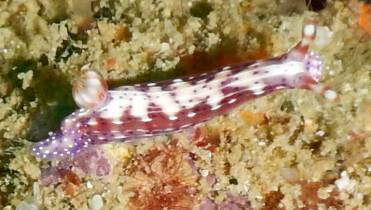 The spotted hypselodoris is an elegant nudibranch |
At left, the Spotted Hypselodoris H. maculosa, ispart of a large genus of nudibranchs, all with elongate bodies and many with a combination of stripes and spots. On this speiceis the rhoniphores are banded with brown-red and white.
At right, the beautiful white and black nudibranch is in the Genus Jorunna, in which there are at present only a few named species. This one is the Funeral Jorunna, J. funebris and is characterized by the black circular markings which appear fuzzy due to fine, erect papillae.
